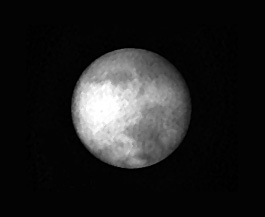

This red light CCD image of Mars was obtained by noted astroimager Gregory Terrance on April 23, 1997 (LS=108.7, De=23.9, Dia.=12.15") at 00:56 UT (CM=013.3) using a 16-inch (41-cm) f/5 Newtonian reflector, at an effective focal ratio (EFR) of f/30, coupled to a Celestron PixCel 255 CCD camera at an exposure of 0.1 seconds. The North Polar Cap (NPC) is apparently very bright to extremely bright (8-9/10) and surrounded by a dark to very dark (2-3/10) collar consisting of Ortygia, Hyperboreus Lacus, and Abalos. Cydonia appears dark to dusky (3-4/10) towards the Np. limb. Mare Acidalium appears dark to very dark (2-3/10) on and f. the CM (Callirrhoes Sinus appears as a dark (3/10), "wedge-shaped" albedo feature on the CM) apparently connected to Hyperboreus Lacus by Abalos. Niliacus Lacus appears dark (3/10) and separated from Mare Acidalium by a thin, bright (7/10) Achillis Pons. Nilokeras appears dark to dusky (3-4/10) adjacent to the f., or morning, limb with Achillis Fons visible over its northern border and Idaeus Fons over its southern border. Sinus Sabaeus appears dark (3/10) over the Sp. limb and apparently connected to Sinus Meridiani (3/10) (Brangaena (Argus) is visible as a thin, dark (3/10) projection from it's f. border over Thymiamata). Margaritifer Sinus, Vulcani Pelagus, and Mare Erythraeum appear dark (3/10) towards the Sf. limb. Oxia Palus is visible as an elongated, dark (3/10) streak Np. Margaritifer Sinus. A thin, dark (3/10) projection is visible along the f. border of Margaritifer Sinus and this may represent the southern origin of Hydaspis Sinus, a transient albedo feature observed by various well known planetary astronomers (i.e. Secchi, Dawes, Kaiser) between 1858 and 1871.
(Legend: N.=north, S.=south, p.=preceding, f.=following,
Np.=north-preceding, Nf.=north-following, Sp.=south-preceding, Sf.=south-following,
MLH=morning limb haze, ELH=evening limb haze, and SLH=southern limb haze)